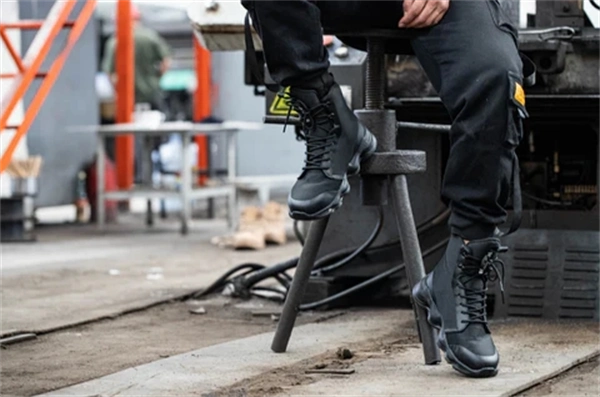Working on Concrete? Choose These Sole Materials to Avoid Foot Pain 😩👷♂️

Hey there, hardworking folks! If you’ve ever spent a long day on your feet, pounding concrete floors, you know the ache that creeps into your soles by quitting time. I’ve been there—construction sites, warehouses, you name it. Hours on concrete can turn your feet into a throbbing mess if you’re not careful. That’s why I’m here to spill the tea on the best sole materials to keep foot pain at bay. No fluff, just real talk from someone who’s felt the burn and figured out what works. Let’s dive in!
Why Concrete Is a Foot’s Worst Enemy
Concrete doesn’t give. It’s hard, unforgiving, and sucks the life out of your feet with every step. Studies show standing on concrete for just 4-6 hours can spike pressure on your joints by up to 50% compared to softer surfaces (trust me, I’ve read the research and felt it firsthand). Without the right sole material, you’re begging for plantar fasciitis, heel spurs, or just plain exhaustion. So, what’s the fix? It’s all about the soles, baby.
Top Sole Materials to Save Your Feet on Concrete
After years of trial and error (and a few pairs of shoes that went straight to the trash), here’s my go-to list of sole materials that actually work. No fancy brand names—just the raw materials that make a difference.
1. EVA (Ethylene Vinyl Acetate) Foam – The Lightweight Lifesaver
Ever wonder why some shoes feel like walking on clouds? EVA foam is the MVP. It’s soft, shock-absorbing, and molds to your foot over time. I wore EVA-soled shoes on a 10-hour warehouse shift, and my feet thanked me. It’s not indestructible, though—expect some wear after a few months—but for comfort, it’s gold.
- Pros: Lightweight, cushiony, affordable.
- Cons: Wears down faster on rough concrete.
- Best for: Long shifts with moderate movement.
2. Polyurethane (PU) – Tough and Bouncy
PU soles are the workhorses of the sole world. They’re denser than EVA but still pack a punch in shock absorption. I’ve had PU soles last me a full year on a construction gig—beat that! They’re a bit heavier, but the trade-off is durability and support.
- Pros: Long-lasting, great cushioning, resists oil and slips.
- Cons: Can feel stiff at first.
- Best for: Heavy-duty jobs with lots of standing.
3. Rubber – The Slip-Proof King
Rubber soles are clutch if you’re dodging spills or slick concrete. They grip like nobody’s business and offer decent cushioning. I’ve slipped less and ached less since switching to rubber soles for outdoor concrete work. Bonus: they’re tough as nails.
- Pros: Slip-resistant, durable, decent comfort.
- Cons: Less cushion than EVA or PU.
- Best for: Wet or uneven concrete surfaces.
4. Memory Foam – Like a Hug for Your Feet
Okay, memory foam isn’t just for mattresses. Some soles use it, and it’s a game-changer. It molds to your foot’s shape, easing pressure points. I tried it during a 12-hour factory shift, and it felt like my feet were getting a spa day. Just watch out—it’s not the toughest material out there.
- Pros: Super comfy, personalized fit.
- Cons: Wears out quicker, not great for heavy-duty wear.
- Best for: Indoor concrete jobs with minimal rough stuff.
Sole Material Comparison Table
Here’s a quick rundown to help you pick what’s right for you:
| Material | Comfort | Durability | Slip Resistance | Best Use Case |
|---|---|---|---|---|
| EVA Foam | ⭐⭐⭐⭐ | ⭐⭐ | ⭐⭐ | Long shifts, light movement |
| Polyurethane | ⭐⭐⭐ | ⭐⭐⭐⭐ | ⭐⭐⭐ | Heavy-duty concrete jobs |
| Rubber | ⭐⭐⭐ | ⭐⭐⭐⭐ | ⭐⭐⭐⭐ | Wet or outdoor concrete |
| Memory Foam | ⭐⭐⭐⭐⭐ | ⭐⭐ | ⭐⭐ | Indoor, low-impact standing |
How to Spot the Right Sole Material for You
Not sure where to start? Ask yourself:
- How long am I on my feet? Longer hours = more cushion (EVA or memory foam).
- Is my concrete wet or rough? Go for rubber or PU.
- Do I move a lot or just stand? Moving = lighter soles (EVA); standing = tougher ones (PU).
Pro tip: Check the shoe’s specs before you buy. Look for terms like “shock-absorbing” or “high-rebound cushioning”—that’s your clue!
Real Talk: My Experience on Concrete
I’ll never forget my first gig on a concrete floor—8 hours in cheap sneakers with zero support. By the end, I was limping like an old man. Switched to PU soles the next week, and it was night and day. My back stopped aching, my heels didn’t scream, and I could actually enjoy a beer after work instead of icing my feet. If I can save you from that misery, I’ve done my job.
FAQ: Your Burning Questions Answered
Q: Can I just add insoles instead of new soles?
A: Sure, insoles can help, but they’re a Band-Aid. A good sole material tackles the root problem—impact. Pair them together for max relief!
Q: How often should I replace my shoes for concrete work?
A: Depends on the material. EVA or memory foam? Every 6-9 months. PU or rubber? Closer to a year. Check for flat spots or cracks—your feet will tell you when it’s time.
Q: Are thicker soles always better?
A: Not always. Thick EVA is dreamy, but thick rubber can feel clunky. Balance is key—test what feels right for you.
Why This Matters (And Why You Should Act Now)
Foot pain isn’t just a “suck it up” thing. Chronic discomfort can mess with your knees, hips, and back—trust me, I’ve seen coworkers sidelined by it. The right sole material isn’t a luxury; it’s a necessity. Plus, who doesn’t want to feel good after a hard day’s work?
Ready to ditch the ache? Check out our comfort-focused work shoe collection and find soles that match your vibe. Your feet deserve it. 👟✨
Final Thoughts
Working on concrete doesn’t have to mean foot pain. Whether you’re vibing with EVA’s cushy goodness, PU’s toughness, rubber’s grip, or memory foam’s TLC, there’s a sole material out there for you. I’ve walked the walk (literally), and these picks have kept me going strong. So, what’s your go-to? Drop a comment—I’d love to hear what works for you!
